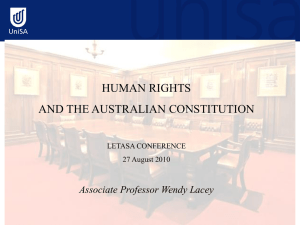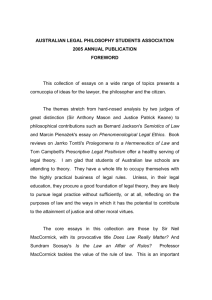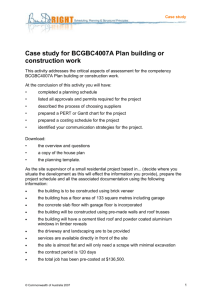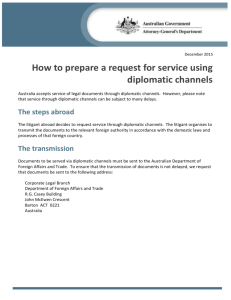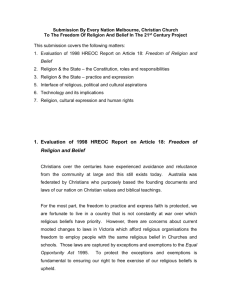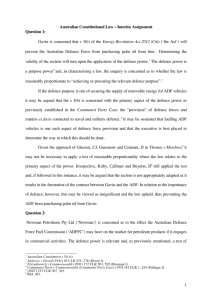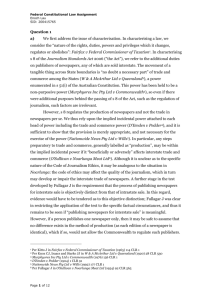How Free is Speech in Australia?
advertisement
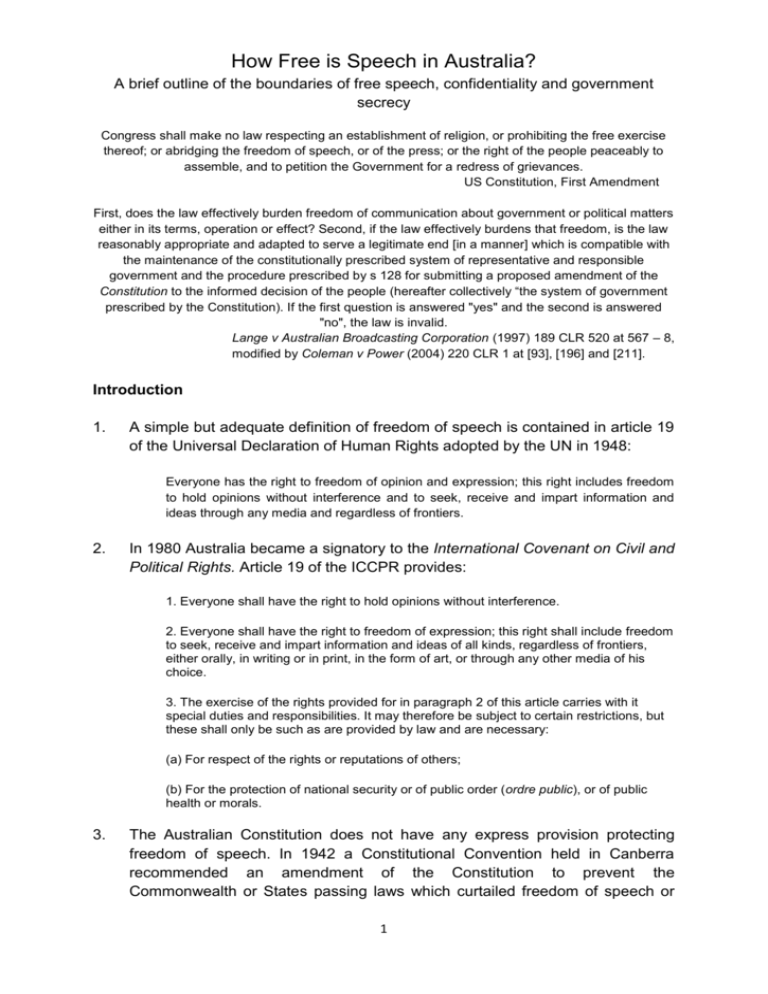
How Free is Speech in Australia? A brief outline of the boundaries of free speech, confidentiality and government secrecy Congress shall make no law respecting an establishment of religion, or prohibiting the free exercise thereof; or abridging the freedom of speech, or of the press; or the right of the people peaceably to assemble, and to petition the Government for a redress of grievances. US Constitution, First Amendment First, does the law effectively burden freedom of communication about government or political matters either in its terms, operation or effect? Second, if the law effectively burdens that freedom, is the law reasonably appropriate and adapted to serve a legitimate end [in a manner] which is compatible with the maintenance of the constitutionally prescribed system of representative and responsible government and the procedure prescribed by s 128 for submitting a proposed amendment of the Constitution to the informed decision of the people (hereafter collectively “the system of government prescribed by the Constitution). If the first question is answered "yes" and the second is answered "no", the law is invalid. Lange v Australian Broadcasting Corporation (1997) 189 CLR 520 at 567 – 8, modified by Coleman v Power (2004) 220 CLR 1 at [93], [196] and [211]. Introduction 1. A simple but adequate definition of freedom of speech is contained in article 19 of the Universal Declaration of Human Rights adopted by the UN in 1948: Everyone has the right to freedom of opinion and expression; this right includes freedom to hold opinions without interference and to seek, receive and impart information and ideas through any media and regardless of frontiers. 2. In 1980 Australia became a signatory to the International Covenant on Civil and Political Rights. Article 19 of the ICCPR provides: 1. Everyone shall have the right to hold opinions without interference. 2. Everyone shall have the right to freedom of expression; this right shall include freedom to seek, receive and impart information and ideas of all kinds, regardless of frontiers, either orally, in writing or in print, in the form of art, or through any other media of his choice. 3. The exercise of the rights provided for in paragraph 2 of this article carries with it special duties and responsibilities. It may therefore be subject to certain restrictions, but these shall only be such as are provided by law and are necessary: (a) For respect of the rights or reputations of others; (b) For the protection of national security or of public order (ordre public), or of public health or morals. 3. The Australian Constitution does not have any express provision protecting freedom of speech. In 1942 a Constitutional Convention held in Canberra recommended an amendment of the Constitution to prevent the Commonwealth or States passing laws which curtailed freedom of speech or 1 the press. The government did not accept the amendment and it was not included in the 1944 referendum1. 4. Since 1973 attempts have been made at the Commonwealth level to legislate for a Bill of Rights – without success. In 2009 the Commonwealth launched a National Human Rights Consultation and various bodies made submissions. The idea of entrenchment – requiring constitutional amendment - appears to have been abandoned and there have been proposals for some legislative form of rights protection falling short of entrenchment. One example is the Law Council’s submission calling for a legislative Charter of Human Rights modelled on the Victorian Charter of Rights and Responsibilities. 5. The National Human Rights Consultation appears to have produced little so far: in 2010 the Attorney-General Department’s webpage announced a National Human Rights Action Plan involving limited measures; a Human Rights (Parliamentary Scrutiny) Bill intended to require scrutiny of new legislation for human rights compatibility, consolidation of existing human rights legislation and a program to educate public servants about human rights and to increase awareness of human rights in policy formulation and administration. A bill to amend the Commonwealth Evidence Act to provide some protection to journalists from being forced to divulge the identity of sources was also introduced in 2010. These bills are presently at the committee stage in the Senate. The High Court steps in 6. It was against a background of failure to achieve constitutional or legislative protection of freedom of speech that the High Court decided the cases of Nationwide News Pty Ltd v Wills (Free Speech Case) (1992) 177 CLR 1 and Australian Capital Television Pty Ltd v Commonwealth (Political Advertising Case) (1992) 177 CLR 106. In Nationwide News the relevant provision of the Industrial Relations Act made it made it an offence to use words “calculated to bring a member of the (Industrial Relations) Commission… into disrepute”. There was no defence such as fair comment or justification. Brennan, Deane, Gaudron and Toohey JJ found the provision to be invalid based on an implied freedom of communication about matters relating to the government of the Commonwealth. In Australian Capital Television the Court considered provisions of the Broadcasting Act which limited paid political advertising during an election period and required broadcasters to make available free time for advertisements according to various conditions. The provisions were unanimously held to be invalid. Brennan, Deane, Gaudron and Toohey JJ found the provisions to be invalid on the basis that the provisions infringed the right to freedom of communication on matters relevant to political discussion 1 Free Speech and the Constitution, Roy Jordan, Research Note No 42 2001 – 02, Parliamentary Library, http://www.aph/.gov.au/Library/pubs/rn/2001 - 02/02rn42.htm, accessed 28/2/2011. 2 that was implied in the system of the representative government for which the Constitution provided. 7. The formulations of the extent of the right varied amongst the judges, including "political discourse", "political and economic matters", "public affairs and political discussion", "all matters relating to the government of the Commonwealth" and "opinions, arguments and information concerning matters intended or likely to affect voting in an election to the Senate or the House of Representatives". 8. In Theophanous v Herald and Weekly Times Ltd (1994) 182 CLR 104 and Stephens v West Australian Newspapers (1994) 182 CLR 211 the Court extended this implied right of freedom of communication to provide a defence to an action for defamation. These judgments were subsequently criticized for not providing a clear ratio or majority and for deficiencies in principle. In Lange v ABC (1997) 189 CLR 520, in a joint judgment of all the justices, the Court reconsidered Theophanous and Stephens. The defence based on the implied constitutional freedom was recast as a defence of qualified privilege and the common law of Australia reinterpreted accordingly. It was held that all Australians have an interest in disseminating and receiving information, opinions and arguments concerning government and political matters that affect the people of Australia. The duty to disseminate such information was simply the correlative of the interest in receiving it. 9. Lange made clear that the freedom of communication was necessarily implied from sections 7 and 24 of the Constitution which provide for elected and representative government and which enable the people to exercise a free and informed choice as electors. 10. The decision in Lange also stated (at 560) that: Those sections do not confer personal rights on individuals. Rather they preclude the curtailment of the protected freedom by the exercise of legislative or executive power…In Cunliffe v Commonwealth Brennan J pointed out… The implication is negative in nature: it invalidates laws and consequently creates an area of immunity from legal control, particularly from legislative control. 11. The approach of the Court to the interpretation of the implied freedom of communication was influenced by the common law approach that "everybody is free to do anything, subject only to the provisions of the law", so that one proceeds "upon an assumption of freedom of speech" and turns to the law "to discover the established exceptions to it": Lange 3 at 564.9 quoting Attorney-General v Guardian Newspapers [No 2] [1990] 1 AC 109 at 283. 12. For the defence to be available the otherwise defamatory statements about political and government matters must be made honestly and without malice and, if published to a wide audience, must be made “reasonably”. Publication beyond what is "reasonably sufficient for the occasion of qualified privilege is unprotected": Lange at 572.5. In all but exceptional cases the proof of reasonableness will fail unless the publisher shows that it was unaware of the falsity of the matter and did not act recklessly in making the publication: Lange at 573.6. 13. The decision in Lange also established that communications beyond Commonwealth matters will be protected, including discussion of matters at state, territory and local government level. These matters are amenable to protection because they might have bearing on the choice that people have to make in federal elections or referendums and on their evaluation of the performance of federal ministers and their departments. The existence of national political parties operating at federal, state, territory and local government levels and the financial dependence of state, territory and local governments on federal funding and policies will also be relevant. Discussion of matters concerning the United Nations and other countries may also be protected. 14. If legislation is a “burden [on] freedom of communication about government and political matters", the test of validity requires an analysis of whether it is “reasonably appropriate and adapted to serve a legitimate end the fulfilment of which is compatible with the maintenance of the constitutionally prescribed system of representative and responsible government”. In Langer v Commonwealth (1996) 186 CLR 302 it was held that a provision of the Commonwealth Electoral Act prohibiting the encouragement of others to vote informally did not impinge on the freedom of communication. 15. In Coleman v Power (2004) 220 CLR 1 the appellant had been convicted of offences under the Vagrants, Gaming and Other Offences Act (Qld) when protesting against police in Townsville. He was distributing pamphlets and, when approached by police, said loudly “This is Constable Brendan Power, a corrupt police officer”. He was charged with using “insulting words”. The words were held to be matters within the freedom of communication that the Constitution protects. McHugh J held that the provision, as an unqualified prohibition on the use of insulting words, went beyond anything that could be reasonably regarded as appropriate and adapted to preventing breaches of the peace. He held the provision to be invalid. Gummow and Hayne JJ and Kirby J held the provision should be read down, taking into account the constitutional protection of freedom of communication about political matters, to a narrower 4 ambit requiring that the insulting words were likely to provoke physical retaliation. They held that on this narrower interpretation the provision was valid but because the appellant’s words did not satisfy that requirement the conviction should be set aside. In their reasons the majority of the court said that test of validity in Lange should be slightly reformulated to read “reasonably appropriate and adapted to serve a legitimate end [in a manner] which is compatible with the maintenance of the constitutionally prescribed system of representative and responsible government”.2 16. In APLA Limited v Legal Services Commissioner NSW (2005) 224 CLR 322 the majority of the Court held that restrictions on lawyers’ advertising in relation to personal injuries was not a communication about government or politics for the purpose of the implied constitutional freedom of communication. 17. The implied freedom of communication does not create an individual right but limits the extent of legislative encroachment on communication about governmental and political matters. Other areas of limitation on free exchange of information 18. Against this general constitutional background the Australian law is a melange of limitations, restrictions and protections of freedom of speech having their origin in the common law, equity and statute. These areas include Crown privilege or public interest immunity, legal professional privilege, court rules for discovery and disclosure, copyright, statutory secrecy provisions such as in the Crimes Act and Australian Crime Commission Act, privacy requirements in the Privacy Act, contractual and statutory limitations on employees and, on the other hand, the freedom of information acts and whistle-blower’s protections such as the Public Interest Disclosure Act (NT) and statutory prohibitions on “hate speech” such as those contained in the Racial Discrimination Act. 19. In the recent decision of Eatock v Bolt [2011] FCA 1103 the applicants alleged that Bolt and the Herald & Weekly Times had breached section 18C of the Racial Discrimination Act which prohibits the doing of an act likely to offend, insult, humiliate or intimidate another person or group of persons because of the race, colour, national or ethnic origin of the person or group. Bromberg J found that the respondents intentionally made imputations that the named “fairskinned Aboriginal people” (his Honour’s description) were not genuinely Aboriginal persons but were motivated by career opportunities and had chosen to falsely identify as Aboriginal. Bromberg J found that the imputations were false. The conduct was not exempted by the defence in section 18D of the Act 2 Coleman was applied by the NT Court of Appeal in Meyerhoff v Darwin City Council (2005) 16 NTLR 222, 190 FLR 344 and Highway v Tudor-Stack (2009) 18 NTLR 58, 226 FLR 135. In Meyerhoff the appellant’s conviction for posting a handbill on a street fixture without a permit contrary to a council by-law was upheld on the basis that the by-law was compatible with the constitutional freedom. In Highway the appellant’s conviction for disturbing the Legislative Assembly while it was in session was upheld on the same basis. 5 because it was not done reasonably and in good faith or in making or publishing fair comment. Bromberg J held that the offensive articles were not exempted because of the manner in which they were written, containing errors of fact, distortions of the truth and inflammatory and provocative language. 20. This is an important decision and demonstrates (subject to any appeal) the balance struck in Australia between freedom of speech and freedom from racial prejudice and intolerance. Similar legislation has been held to be incompatible with the First Amendment in the USA3. 21. Two areas of particular interest for freedom of speech are the law of confidential information, particularly when claimed by government against media, and the protection, or lack of protection, of journalist’s sources. Confidential information 22. The classic formulation of the necessary elements of a breach of confidence was set out by Megarry J in Coco v A N Clark (Engineers) Ltd [1969] RPC 41: (a) The information must “have the necessary quality of confidence about it”; (b) It must have been imparted in circumstances importing an obligation of confidence, and (c) There must be actual or threatened use of the information without consent4. 23. The requirement that the information must have been received in circumstances importing an obligation of confidence may include information improperly or surreptitiously obtained: Commonwealth v John Fairfax & Sons Ltd (1980) 147 CLR 39 at 50.6. The plaintiff must show, not only that the information is confidential in quality and that it was imparted so as to import an obligation of confidence, but also that there will be "an unauthorised use of that information to the detriment of the party communicating it": Commonwealth v John Fairfax & Sons at 51.7 per Mason J (as he then was) quoting Coco v A N Clarke (Engineers) Ltd at 47. In Commonwealth v John Fairfax & Son Mason J said "It may be a sufficient detriment to the citizen that disclosure of information relating to his affairs will expose his actions to public discussion and criticism”. Other examples are publication of Aboriginal cultural secrets: Foster v Mountford (1976) 29 FLR 233 and publication of footballers’ positive drug tests: Australian Football League v The Age (No 2) (2006) 15 VR 419. 3 For example, RAV v City of St Paul 505 US 377 (1992) and Corry v Stanford (Cal. Super. Ct. Feb 27, 1995). See also Moorgate Tobacco Co Ltd v Phillip Morris Ltd [No 2] (1984) 156 CLR 414 at 438.1- 438.5, Smith Kline & French Laboratories (Aust) Ltd v Secretary, Department of Community Services and Health (1990) 22 FCR 73 at 87, Optus Networks Pty Ltd v Telstra Corporation Ltd [2010] FCFCA 21 at [39]. 4 6 24. In the case of government the law of confidential information has a restricted application. In Commonwealth v John Fairfax & Son the Sydney Morning Herald proposed to publish documents on Australia’s defence and foreign policy, including documents about the negotiations for US bases in Australia, the presence of the Soviet navy in the Indian Ocean and the structure of the US and UK intelligence services. There had been some limited publication of the material by sale of a book and the sale of some newspapers containing extracts from the book. The Commonwealth sought to restrain by injunction the publication on three bases; that the documents had been obtained in breach of section 79 of the Crimes Act which makes the dissemination of “secret” documents by public servants an offence, that the threatened publication of the documents was a breach of confidence and that the Commonwealth held copyright in the documents and the threatened breach of copyright should be restrained by injunction. 25. Mason J held that a threatened breach of the criminal law would only be restrained by injunction in exceptional cases, usually where the penalty was inadequate or there was an emergency. That did not apply here. 26. In relation to the threatened disclosure of confidential information Mason J rejected the suggestion that the relevant law applied in the same way to both government and the individual. He said that in the case of the citizen it may be sufficient detriment that it “will expose his actions to public discussion and criticism” but that cannot be relevant in the case of government. He said at 52.2: It is unacceptable in our democratic society that there should be a restraint on the publication of information relating to government when the only vice of that information is that it enables the public to discuss, review and criticise government action. Accordingly, the court will determine the government's claim to confidentiality by reference to the public interest. Unless disclosure is likely to injure the public interest, it will not be protected. 27. However, the Commonwealth was successful in obtaining an injunction on the basis that the documents were documents on which the Commonwealth held copyright and the usual remedy for a threatened breach of copyright was injunction. 28. The approach of Mason J to the public interest has most commonly found expression in the cases under freedom of information legislation5. 5 for example, Harris v ABC (1983) 78 FLR 236, Public Service Board (Vic) v Wright (1986) 160 CLR 145, Director of Public Prosecutions (Vic) v Smith [1991] 1VR 63. 7 29. Attorney-General (UK) v Heineman Publishers Australia (Spycatcher's Case) (1988) 165 CLR 30 concerned the British government's attempt to restrain the publication in Australia of Peter Wright’s memoir about his time with MI5, including an account of alleged illegal activities by the Security Service. In the trial at first instance Powell J rejected the claim for injunction and held that much of the information in Spycatcher was no longer confidential (having been widely published in Scotland, New Zealand, the United States and elsewhere) and that publication would not be detrimental to the British government or the Security Service. The New South Wales Court of Appeal dismissed the Attorney-General's appeal holding that the claim was not justiciable in an Australian court since it involved an attempt to enforce indirectly the public laws of a foreign state or, alternatively, involved a determination of the question whether publication would be detrimental to the public interest in the United Kingdom. In the High Court the majority dismissed the appeal on the same ground and Brennan J on the ground that the court would not enforce an obligation of confidence in an action brought to protect intelligence secrets and confidential political information of a foreign government. 30. ABC v Lenah Game Meats (2001) 208 CLR 199 concerned animal liberationists who trespassed on Lenah’s land to film the commercial slaughter of possums. They passed the film on to the ABC which proposed to broadcast the film. The majority of the Court held that while this was private information it was not confidential information in the sense necessary for the grant of an injunction. In the majority decisions, Gleeson CJ expressed the opinion that the implied freedom of communication about government and political matters identified in Lange was a matter that ought to have been considered in deciding whether to grant an injunction. Kirby J held the discussion of animal welfare matters was encompassed by the implied freedom. Gummow and Hayne JJ and Gaudron J found it unnecessary to reach a conclusion on the point. 31. Lenah Meats is also notable for the discussion of the potential tort of invasion of privacy, particularly in the decisions of Gummow and Hayne JJ and Kirby J. Each of these judges doubted that any such tort, even if recognized, would apply to a corporation6. Journalist’s confidential sources 32. Journalists’ confidential sources are not protected in Australia. In John Fairfax & Sons v Cojuangco (1988) 165 CLR 346 the Sydney Morning Herald published an article claiming that Cojuangco was a crony of President Marcos and implied he was involved in corrupt dealings. The article identified the source of information as a "leading local US bank". Cojuangco sought 6 A bold step in this direction was taken by Judge Skoien of the Queensland District in Grosse v Purvis [2003] QDC 151. 8 discovery of the name of the source. The defendant argued that the "newspaper rule" provided absolute protection in the circumstances from compulsion to identify the source. The Court held that the "newspaper rule" was no more than a rule of practice where courts were unwilling to grant this type of discovery if there was a good cause of action against the newspaper. In this case it was argued that the newspaper was likely to have a good defence of qualified privilege. Accordingly, discovery was ordered. The Court discussed the countervailing public interest in the free discussion and evaluation of public affairs and the danger that potential sources of information would be discouraged if their identity could be quickly disclosed in proceedings against the newspaper. The Court recognised that the free flow of information was a vital ingredient in investigative journalism which is such an important feature of our society. Ultimately, the Court decided that this should not outweigh the interest of the individual in an effective remedy and that the liability of the media and journalists to disclose their sources in interests of justice was necessary to ensure that the great power of the media was not abused. 33. It is notable that the recent case of the police investigation of phone records of NT News journalist Justin O'Brien attracted national and international attention. According to media reports the NT Ombudsman's report (which is not public) into the matter found that the investigation was lawful but that its extent was unreasonable. The power of the police to obtain access to the telephone records was apparently based on section 313 of the Telecommunications Act which requires carriers to give access to certain records, without a warrant, for the purpose of enforcing the criminal law, protecting the public revenue and safeguarding national security. 34. A bill, the Evidence Amendment (Journalists’ Privilege) Bill, has been introduced by Senator Brandis to amend the Commonwealth Evidence Act. It would apply to any civil or criminal proceeding and provide that neither a journalist nor his or her employer was compellable to identify a source who had been promised that his or her identity would not be disclosed. If the court was satisfied that the public interest in disclosure outweighed any likely adverse effect of disclosure on the informant and the public interest in the communication of the facts and opinions then disclosure may be ordered on such terms and conditions as it thinks fit. A Charter of Rights? 35. The piecemeal and confusing nature of the law has encouraged calls, including by the Law Council of Australia, for a national charter of rights. The Law Council identified the Victorian Charter of Human Rights and Responsibilities Act 2006 as a suitable model. It enumerates a range of human rights but does not require their absolute recognition. It requires a statement of compatibility for proposed new legislation. It permits parliament to declare legislation has effect 9 despite incompatibility with the Act. It requires courts to interpret legislation, so far as is possible, in a way that is consistent with human rights. If legislation cannot be interpreted in this way the Supreme Court may make a declaration to that effect. The High Court has recently considered the Act in Momcilovic v The Queen [2011] HCA 34. 36. A charter of rights or even entrenchment of some rights should be considered in the Northern Territory, particularly if it is to progress in its claim for statehood. A Young 29 September 2011 10


